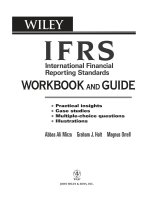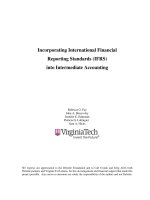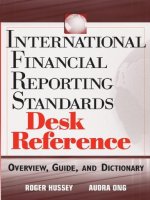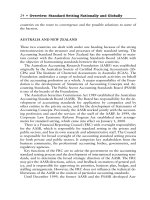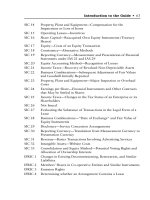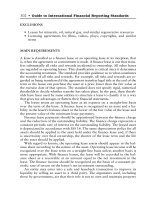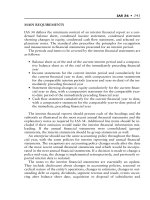INTERNATIONAL FINANCIAL REPORTING STANDARDS DESK REFERENCE Overview, Guide, and Dictionary phần 3 ppt
Bạn đang xem bản rút gọn của tài liệu. Xem và tải ngay bản đầy đủ của tài liệu tại đây (151.06 KB, 39 trang )
SIC 14 Property, Plant and Equipment—Compensation for the
Impairment or Loss of Items
SIC 15 Operating Leases—Incentives
SIC 16 Share Capital—Reacquired Own Equity Instruments (Treasury
Shares)
SIC 17 Equity—Costs of an Equity Transaction
SIC 18 Consistency—Alternative Methods
SIC 19 Reporting Currency—Measurement and Presentation of Financial
Statements under IAS 21 and IAS 29
SIC 20 Equity Accounting Method—Recognition of Losses
SIC 21 Income Taxes—Recovery of Revalued Non-Depreciable Assets
SIC 22 Business Combinations—Subsequent Adjustment of Fair Values
and Goodwill Initially Reported
SIC 23 Property, Plant and Equipment—Major Inspection or Overhaul
Costs
SIC 24 Earnings per Share—Financial Instruments and Other Contracts
that May be Settled in Shares
SIC 25 Income Taxes—Changes in the Tax Status of an Enterprise or its
Shareholders
SIC 26 Not Issued
SIC 27 Evaluating the Substance of Transactions in the Legal Form of a
Lease
SIC 28 Business Combinations—“Date of Exchange” and Fair Value of
Equity Instruments
SIC 29 Disclosure—Service Concession Arrangements
SIC 30 Reporting Currency—Translation from Measurement Currency to
Presentation Currency
SIC 31 Revenue—Barter Transactions Involving Advertising Services
SIC 32 Intangible Assets—Website Costs
SIC 33 Consolidation and Equity Method—Potential Voting Rights and
Allocation of Ownership Interests
IFRIC 1 Changes in Existing Decommissioning, Restoration, and Similar
Liabilities
IFRIC 2 Members’ Shares in Co-operative Entities and Similar Instruments
IFRIC 3 Emission Rights
IFRIC 4 Determining whether an Arrangement Contains a Lease
Introduction to the Guide • 63
ccc_hussey_int_59-64.qxd 2/16/05 12:30 PM Page 63
CURRENT ACTIVITIES
ED 7 Financial Instruments: Disclosures
Project Accounting Standards for Small and Medium-Sized Entities
Project Projects Relating to Financial Instruments
Project Issues Relating to IFRS 3 Business Combinations
Project Business Combinations—Phase 2 Application of the Purchase
Method
Project Consolidation (including SPEs)
Project Convergence—Convergence Project General Information
Project Convergence—Post-employment Benefits
Project Extractive Activities
Project Insurance Contracts—Phase II
Project Performance Reporting/Reporting Comprehensive Income
Project Liabilities and Revenue Recognition
Project Convergence—Joint Ventures
Project Convergence—IAS 20 Government Grants and Disclosure of
Government Assistance
Project Conceptual Framework
Research Leases
Research Extractive Activities
Research Joint Ventures
Research Measurement
64 • Guide to International Financial Reporting Standards
ccc_hussey_int_59-64.qxd 2/16/05 12:30 PM Page 64
Framework for
the Preparation
and Presentation
of Financial
Statements
65
ISSUED
April 1989
BACKGROUND
The “Framework” is not an accounting standard but was issued by the IASC
to help develop international standards and to promote harmonization. It
was also considered that the “Framework” would assist preparers, auditors,
users, and others who are involved with or are interested in accounting and
financial reporting issues. The “Framework” was adopted by the IASB in
April 2001.
The argument put forward by the IASC was that there are differences in fi-
nancial statements on a global basis due to national, social, economic, and le-
gal reasons. Different countries have also made various assumptions about
the potential users of financial statements and their particular need for certain
types of information. The result of this is that different criteria and measure-
ment principles have been adopted, and there are various definitions in use for
assets, liabilities, equity, income, and expenses. The purpose of the IASC in is-
suing the “Framework” was to narrow these differences by seeking to harmo-
nize regulations, accounting standards, and procedures for the preparation
and presentation of financial statements.
ccc_hussey_frame_65-70.qxd 2/16/05 12:30 PM Page 65
ASSUMPTIONS
The “Framework” makes a number of assumptions regarding financial state-
ments, which explain how it arrives at some of its definitions and guidance.
Financial statements are regarded as general-purpose documents designed to
meet the information needs of a very wide range of users, including investors,
employees, customers, the government, and the public. Although the “Frame-
work” emphasizes the economic decision-making needs of users, it also states
that financial statements are appropriate for assessing the stewardship of
management.
The “Framework” is intended for different accounting models and con-
cepts of capital and capital maintenance. The context, however, is the prevail-
ing model of recoverable historic cost and the nominal financial capital
maintenance concept.
The two familiar assumptions that the “Framework” contains are the ac-
cruals basis of accounting and the going concern concept.
STRUCTURE OF THE “FRAMEWORK”
The main headings of the “Framework” are as follows:
• The Objective of Financial Statements
• Underlying Assumptions
• Qualitative Characteristics of Financial Statements
• The Elements of Financial Statements
• Recognition of the Elements of Financial Statements
• Measurement of the Elements of Financial Statements
• Concepts of Capital and Capital Maintenance
We have briefly addressed the first two headings above, and the third,
Qualitative Characteristics of Financial Statements, is very similar to Concep-
tual Frameworks or Statements of Principles issued by various countries. Es-
sentially, the main characteristics are understandability, relevance, reliability,
and comparability. These are discussed by reference to a number of support-
ing characteristics. The section concludes by stating that financial statements
that possess such characteristics will normally give a true and fair view or that
the information has been presented fairly.
The part of the “Framework” that is possibly the most influential are the
sections dealing with the elements of financial statements and their recogni-
tion and measurement.
66 • Guide to International Financial Reporting Standards
ccc_hussey_frame_65-70.qxd 2/16/05 12:30 PM Page 66
THE ELEMENTS OF FINANCIAL STATEMENTS
The elements are discussed in two categories: those relating to financial posi-
tion and those relating to performance. The former covers assets, liabilities,
and equity. Performance relates to income and expenditure.
Paragraph 49 offers the following definitions as regards to financial po-
sition:
• “An asset is a resource controlled by the enterprise as a result of past
events and from which future economic benefits are expected to flow to
the enterprise.”
• “A liability is a present obligation of the enterprise resulting from past
events, the settlement of which is expected to result in an outflow from
the enterprise of resources embodying economic benefits.”
• “Equity is the residual interest in the assets of the enterprise after de-
ducting all its liabilities.”
Paragraph 70 offers the following definitions as regards to performance:
• “Income is increases in economic benefits during the accounting period
in the form of inflows or enhancements of assets or decreases in liabili-
ties that result in increases in equity, other than those relating to contri-
butions from equity participants.”
• “Expenses are decreases in economic benefits during the accounting pe-
riod in the form of outflows or depletions of assets or occurrences of lia-
bilities that result in decreases in equity, other than those relating to
distributions to equity participants.”
The section develops these five definitions by discussions of their various
aspects and reference to examples. These definitions have been used as the
bedrock of international accounting standards. Although the complications of
global business and the sophistication of accounting and financial practices
have stretched the boundaries of the definitions, their essence has not been
lost.
RECOGNITION AND MEASUREMENT OF THE ELEMENTS
Elements that meet the criteria for recognition are incorporated in the balance
sheet or income statement, as appropriate. There are two hurdles to overcome
to achieve recognition. First, it must be probable that any future economic
benefit will flow to the enterprise. Secondly, it must be possible to measure the
Framework for the Preparation and Presentation • 67
ccc_hussey_frame_65-70.qxd 2/16/05 12:30 PM Page 67
cost or value reliably, and this includes making a reasonable estimate. Mea-
surement is a key criteria underpinning many standards.
The “Framework” explains the following measurement bases:
• Historical cost where assets are recorded at cash, cash equivalents, or
fair value at acquisition and liabilities at the amount received in ex-
change for the obligation
• Current cost where assets are carried at the amount needed to acquire
the same asset and liabilities at the undiscounted amount of cash or cash
equivalents to settle the obligation currently
• Realizable value where assets are carried at the proceeds expected to be
received for their orderly disposal and liabilities at the undiscounted
amount of cash or cash equivalent to settle them in the normal course of
business
• Present values where assets are carried at the present discounted value of
the future net cash flows they are expected to generate and liabilities at
the present value of future net cash outflows required to be settled in the
normal course of business
The measurement basis most commonly used is historical cost, but in re-
cent years there has been a move at the international level to employ other
bases where they seem appropriate. The “Framework” was issued before
“fair value” was accepted as a measurement basis, and therefore it does not
appear in the document. Fair value is defined in several standards issued sub-
sequently.
CONCEPTS OF CAPITAL AND CAPITAL MAINTENANCE
This section is important, since the choice of concepts will determine the ac-
counting model that will be used. Capital concepts fall into two categories: Fi-
nancial capital is regarded as the equity or net assets; physical capital is the
productive capacity of the enterprise.
In order to maintain financial capital, the amount of net assets at the end
of the period must be the same as the net assets at the beginning of the period,
excluding transactions with owners. If the net assets at the end of the period
are greater, a holding gain or “profit” is made. If the financial capital is de-
fined in terms of nominal monetary units, that “profit” does not reflect in-
creases in the general rise of prices. If financial capital is defined in terms of
constant purchasing power units, “profit” represents the increase in invested
purchasing power over the period. In this case, only the price increase of as-
sets that is greater than the general level of prices will be regarded as “profit.”
68 • Guide to International Financial Reporting Standards
ccc_hussey_frame_65-70.qxd 2/16/05 12:30 PM Page 68
To maintain physical capital, the current cost basis of measurement must
be adopted. Price changes affecting the assets and liabilities are regarded as
changes in the measurement of the physical productive capacity and are re-
ferred to as capital maintenance adjustments. It is only the amounts in excess
of that required to maintain the physical capital are regarded as “profit.”
CONCLUSIONS
Despite the “Framework” being issued over 15 years ago, there have been no
attempts to make amendments. One could argue that this is evidence of its ro-
bustness. Critics, however, would claim that it is because the “Framework” is
too general in nature, and strengthening it would improve financial state-
ments but could lead to controversy. The conceptual frameworks or state-
ments of principles issued by individual countries do not conflict or depart
from the approach of the IASB in any material matters and this has helped its
acceptability.
It is important to remember that the “Framework” is not an accounting
standard, and, if there is a conflict between the “Framework” and an Interna-
tional Financial Reporting Standard, the requirements of the standard pre-
vails. Where there is not a standard on a particular accounting issue, the
framework will help in establishing the appropriate policy and practice.
The “Framework” has been a useful document for both the IASC and the
IASB. In particular, under the latter body, the influence of the “Framework”
has been apparent in many of the standards. However, many national stan-
dard setters have their own conceptual framework. Although these national
frameworks have many similarities, there are also differences. In addition, the
frameworks were issued prior to the consideration of many complex account-
ing issues such as derivatives and financial instruments. A major development
in convergence would be an agreed and adopted international framework.
Currently, the IASB and the U.S. Financial Accounting Standards Board
(FASB) are in early discussions on the convergence of conceptual frameworks.
Even at this preliminary stage, it is recognized that convergence cannot take
place unless there are significant improvements. It is a lengthy project to de-
vise a new conceptual framework, but it is imperative that this is undertaken
in order to achieve international harmonization.
Framework for the Preparation and Presentation • 69
ccc_hussey_frame_65-70.qxd 2/16/05 12:30 PM Page 69
ccc_hussey_frame_65-70.qxd 2/16/05 12:30 PM Page 70
IAS 1
Presentation of Financial
Statements
ISSUED OR LAST REVISED
December 2003
EFFECTIVE DATE
January 1, 2005
PROBLEM AND PURPOSE
This standard was revised in 2003 as part of the IASB’s improvement project.
The fundamental approach to the presentation of financial statements has not
been altered but user problems in dealing with alternatives and conflicts have
largely been resolved. The main issues that the revision has addressed are
achieving a fair presentation, classification of liabilities, treatment of extraor-
dinary items, and some additional disclosures.
SCOPE
All general-purpose financial statements prepared and presented in accor-
dance with IFRSs.
EXCLUSIONS
• Interim financial reports (IAS 34)
• Special purpose financial reports
IAS 1 • 71
ccc_hussey_ias01_71-114.qxd 2/16/05 12:30 PM Page 71
MAIN REQUIREMENTS
The standard states that a complete set of financial statements includes the
following:
• A balance sheet
• An income statement
• A statement of changes in equity showing either all changes in equity or
those changes arising from transactions with equity holders
• A cash flow statement
• A summary of significant accounting policies and other explanatory notes
Although the standard refers only to these financial statements, they are
frequently included with other information in a published document referred
to as the Annual Report and Accounts, or similar. The standard includes illus-
trative examples of the financial statements. The main headings and subhead-
ings of a balance sheet are:
ASSETS
Non-current assets
Line by line items ———
Subtotal ———
Current assets
Line by line items ———
Sub-total ———
Total assets ———
———
EQUITY AND LIABILITIES
Equity attributable to equity holders of the parent
Line by line items ———
Sub-total ———
Minority interest
Total equity ———
Non-current liabilities
Line by line items ———
Total non-current liabilities ———
72 • Guide to International Financial Reporting Standards
ccc_hussey_ias01_71-114.qxd 2/16/05 12:30 PM Page 72
Current liabilities
Line by line items ———
Total current liabilities ———
Total liabilities ———
Total equity and liabilities ———
———
Certain information must be disclosed on the balance sheet. The minimum
requirements for these line items are as follows:
• Property, plant, and equipment
• Investment property
• Intangible assets
• Held for sale non-current assets and disposal groups
• Financial assets
• Biological assets
• Investments accounted for under the equity method
• Inventories
• Trade and other receivables
• Cash and cash equivalents
• Trade and other payables
• Liabilities included in disposal groups held for sale
• Current tax liabilities and assets
• Deferred tax liabilities and assets
• Provisions
• Financial liabilities
• Minority interest presented as part of equity
• Issued equity capital and reserves
Further details of subclassifications should be disclosed either on the bal-
ance sheet or in the notes.
All items of income and expense recognized in the financial period must
be included in the profit or loss unless a standard or an interpretation re-
quires otherwise. The income statement can present the analysis of expenses
based on either the nature of expenses or their function. With the former,
expenses are aggregated in the income statement according to their nature
(for example, depreciation, purchases of material, and employee benefits).
The second form of analysis is the function of expense, more commonly
known as the “cost of sales.” This classifies expenses according to their
function as part of cost of sales, or the cost of other administrative activi-
ties. The most useful difference between the two is that the cost of sales
IAS 1 • 73
ccc_hussey_ias01_71-114.qxd 2/16/05 12:30 PM Page 73
method provides a figure for gross profit. The main headings and subhead-
ings of the income statement are:
THE NATURE OF EXPENSES FORMAT
Revenue X
Other income X
Changes in inventories of finished goods
and work in progress X
Raw materials and consumables used X
Employee benefit costs X
Depreciation and amortization expense X
Other expenses X
Total expenses (X)
Profit X
THE COST OF SALES FORMAT
Revenue X
Cost of sales (X)
Gross profit X
Other income X
Distribution costs (X)
Administrative expenses (X)
Other expenses (X)
Profit X
The Statement of Changes in Equity is part of the set of financial state-
ments. Changes in equity are attributable to the increase or decrease in net as-
sets during the period, except for those transactions that have taken place
directly with the shareholder. The statement should include the following in-
formation:
• The profit for the period.
• Each item that has been reported directly in equity rather than the in-
come statement.
• The total income or expense for the period. This is the sum of the first
two items with any allocation to minority shareholders clearly separated.
74 • Guide to International Financial Reporting Standards
ccc_hussey_ias01_71-114.qxd 2/16/05 12:30 PM Page 74
• The effect of any changes in accounting policy, or the correction of an
error.
The types of transactions that are taken directly to equity are reversal of
impairment losses previously taken to equity (IAS 36), foreign exchange dif-
ferences arising on consolidation (IAS 21), and revaluation surpluses on non-
current assets (IAS 16).
IAS 1 also requires a full reconciliation of each reserve to be presented and
the amount of any transaction that has taken place with shareholders to be
separately identified.
In preparing the full set of financial statements, the following assumptions
and considerations should be applied:
• The business is a going concern and will continue to operate into the
foreseeable future.
• The accrual concept is used except for the cash flow statement.
• The presentation and classification of items in the financial statements
will be consistent from one financial period to the next.
• Each material class of similar items is presented separately in the finan-
cial statements.
• Dissimilar items are presented separately unless they are immaterial.
• No offsetting of assets and liabilities, or income and expenses, is allowed
unless this is covered by a standard.
• Comparative information for the previous period should be disclosed
for all amounts reported in the financial statements, except where a
standard permits or requires.
IAS 1 requires that financial statements present fairly the financial position,
financial performance, and cash flows. By complying with IFRSs, and provid-
ing any additional information necessary, it is presumed that financial state-
ments give a fair presentation. Where financial statements comply with IFRSs,
an explicit and unreserved statement must be made in the notes to that effect.
An important part of the standard addresses the issue of compliance. As
discussed in Part One of this book, the United Kingdom has the concept of
“true and fair.” This means that, in certain limited circumstances, entities are
able to depart from a standard where it considers that compliance would re-
sult in the financial statements not giving a “true and fair view.” This concept
is partially weakened but retained in IAS 1. The standard states that where an
entity considers that compliance with a particular standard or interpretation
would be so misleading, it need not comply with the provisions. This is likely
to be a very rare occurrence, and the entity must disclose that it has not com-
plied with a particular standard, the title of the standard and the differences
in treatment, and the financial impact of non-compliance.
IAS 1 • 75
ccc_hussey_ias01_71-114.qxd 2/16/05 12:30 PM Page 75
IAS 2
Inventories
ISSUED OR LAST REVISED
December 2003
EFFECTIVE DATE
Financial statements covering periods beginning on or after January 1, 2005.
PROBLEM AND PURPOSE
A major issue in accounting for inventories is determining the amount of cost
that will be recognized as an asset and carried forward to the future financial
period, when the related revenues are recognized. IAS 2 gives guidance on the
methods of determining cost and its subsequent recognition as an expense, in-
cluding any write-downs to net realizable value. The standard also explains
the formulae to be applied in assigning costs to inventories.
In some industries, the value of inventories can be significant. In a man-
ufacturing entity, accounting for inventories will require judgment, particu-
larly in respect of goods in the production process and in identifying
costs attributable to specific inventory items. The appropriate determina-
tion of the cost of inventories and the proper treatment as an expense is im-
portant as it has a direct effect on the profit or loss reported for the
financial period.
SCOPE
• Finished goods that are held for sale in the ordinary course of business
• Work in process in production intended for sale in the ordinary course
of business
• Raw materials that comprise materials and supplies to be used in pro-
duction
76 • Guide to International Financial Reporting Standards
ccc_hussey_ias01_71-114.qxd 2/16/05 12:30 PM Page 76
EXCLUSIONS
• Work in progress arising from construction contracts (IAS 11 Construc-
tion Contracts)
• Financial instruments (IAS 39 Financial Instruments)
• Biological assets related to agricultural activity and agricultural produce
at the point of harvest (IAS 41 Agriculture)
MAIN REQUIREMENTS
Inventories should be measured at the lower of cost and net realizable value
(NRV). Net realizable value is the estimated selling price in the ordinary course
of business, less the estimated cost of completion and the estimated costs neces-
sary to make the sale. Inventory losses and any write-downs to net realizable
value should be recognized in the financial period in which they occur. If circum-
stances arise where a reversal of the write-down is justified, then this should be
treated as a reduction in expense in the period that the reversal occurs. A rever-
sal of a write-down is unlikely to be a frequent occurrence. The cost of invento-
ries, other than those for which specific identification of costs are appropriate, is
to be calculated by using the first-in, first-out (FIFO) or weighted average cost.
The last-in, first-out (LIFO) method is not allowed under the standard.
Cost includes the following:
• Costs of purchase (including taxes, transport, and handling) net of trade
discounts received
• Costs of conversion (including fixed and variable manufacturing over-
heads)
• Other costs incurred in bringing the inventories to their present location
and condition
Cost excludes the following:
• Abnormal waste
• Storage costs
• Administrative overheads unrelated to production
• Selling costs
• Foreign exchange differences arising directly from the recent acquisition
of inventories invoiced in a foreign currency
• Interest cost when inventories are purchased with deferred settlement
terms
IAS 2 • 77
ccc_hussey_ias01_71-114.qxd 2/16/05 12:30 PM Page 77
It is not acceptable to value inventories on a variable cost basis or to ex-
clude a part of the overheads from the value by arguing that prudence has
been applied by writing off those overheads in the current period. Fixed over-
heads should be allocated to each production process on a systematic and
consistent basis and should be determined on normal levels of production.
Selling or administration overheads should not be included in the valuation,
unless there is a firm sales contract, and unless design, marketing, and selling
costs were incurred before production started.
Normally, interest cannot be included as part of the valuation of invento-
ries. There is the exception of maturing inventories, such as alcoholic spirits,
where it can be reasonably argued that the interest has been incurred in hold-
ing the inventory as part of the production process and the product is not
ready for sale until that process has been completed. Whisky drinkers will
support this argument.
Where an entity may transfer goods internally from one department or di-
vision to another at a “transfer” price that does not represent the actual cost,
any profits or losses should be eliminated from the inventory valuation.
When inventories are sold, the carrying amount of these inventories should
be recognized as an expense in the same period that the revenue is recognized.
This expense is usually referred to as the cost of goods sold or cost of sales.
ILLUSTRATIVE EXAMPLE: THE PRINCIPLE OF THE LOWER OF
COST AND NET REALIZABLE VALUE
At the year-end, a manufacturer has 2000 items in inventory and the total
production cost per unit is $4. The best estimate of the selling price of the to-
tal inventory at that date is $6,500, and it is anticipated that $250 would be
incurred in making the sale. At the year-end, the value of the inventory is
$6,250; that is, the selling price of $6,500 less the selling costs of $250. The
write-down of inventory of $1,750 (cost $8,000 – NRV$6,250) should be
recognized as an expense in the period. In subsequent periods, new assess-
ments of the net realizable value will be made until the inventories are sold. If
a write-down to realizable value is of such size, incidence or nature that it is
deemed exceptional, then it should be separately disclosed.
MAIN DISCLOSURES
• Accounting policy for measuring inventories including the cost formula
used
• Carrying amounts detailing any inventory pledged for securities
78 • Guide to International Financial Reporting Standards
ccc_hussey_ias01_71-114.qxd 2/16/05 12:30 PM Page 78
• Expensed write-downs and reversals
• Cost of inventories recognized as an expense
EXAMPLES OF RELATED NATIONAL STANDARDS
Australia: AASB 1019
Canada: CICA Handbook 3030
Malaysia: MASB 2
New Zealand: FRS 4
Taiwan: SFAS 10
United Kingdom: SSAP 9
IAS 7
Cash Flow Statements
ISSUED OR LAST REVISED
December 1992
EFFECTIVE DATE
Financial statements covering periods beginning on or after January 1, 1994.
PROBLEM AND PURPOSE
Knowledge of cash flow information is helpful to users of financial state-
ments. The user can assess both the changes in net assets and the financial
structure of the entity by evaluating cash flow information in the context of
the other financial statements. The potential control that can be effected by an
entity over the amounts and timings of cash flows for adapting to changing
circumstances and opportunities can also be assessed. IAS 7 requires cash
flows to be classified into operating, investing, and financing activities in the
IAS 7 • 79
ccc_hussey_ias01_71-114.qxd 2/16/05 12:30 PM Page 79
cash flow statement. The information enables users to assess the entity’s abil-
ity to generate cash and cash equivalents, and to use those cash flows. IAS 7
includes an example of a cash flow statement for all entities other than finan-
cial institutions. An example of a cash flow statement for a financial institu-
tion is also illustrated in the standard.
SCOPE
All entities producing financial statements that comply with IFRSs.
MAIN REQUIREMENTS
The purpose of a cash flow statement is to analyze changes in cash and cash
equivalents during a financial period. Statements can be drawn up using ei-
ther the direct method (encouraged by IASB), where each major class of gross
cash receipts and gross cash payments are disclosed; or the indirect method
(accepted by IASB) that adjusts the net profit or loss for the effects of non-
cash transactions. Both methods will give a figure for the cash flow from op-
eration activities. The direct method, however, provides the detail of the cash
flows that make up the total of cash flows from operating activities. The indi-
rect method makes adjustments to the net profit or loss for the period (for ex-
ample adding back depreciation) to arrive at the total cash flow figure.
For the purpose of IAS 7, cash and cash flow equivalents should be incor-
porated. These include the following:
• Cash on hand and deposits that can be withdrawn immediately in cash
without suffering any penalties
• Short-term, highly liquid investments that are readily convertible to a
known amount of cash and that are subject to an insignificant risk of
changes in value
• Bank overdrafts that are repayable on demand and are an integral part
of cash
• Equity investments if they are in substance a cash equivalent (for in-
stance, preferred shares acquired within three months of their specified
redemption date)
The cash flow statement must classify the information under three main
headings:
Operating activities: The main revenue-producing activities of the enter-
prise, for example, cash received from customers and cash paid to sup-
pliers and employees.
80 • Guide to International Financial Reporting Standards
ccc_hussey_ias01_71-114.qxd 2/16/05 12:30 PM Page 80
Investing activities: The acquisition and disposal of long-term assets and
other investments that are not considered to be cash equivalents, for ex-
ample, acquisition of plant and equipment.
Financing activities: Activities that alter the equity capital and borrow-
ing structure of the enterprise, for example, cash from issuing shares.
The standard explains the treatment of certain items, the main ones being:
• Interest and dividends received and paid may be classified as operating,
investing or financing cash flows but must be treated consistently.
• Tax cash flows on income are normally classified as operating unless
they can be specifically identified under another heading.
• Extraordinary items should be disclosed separately under the most ap-
propriate heading.
• Foreign currency cash flows arising from transactions should be
recorded at the rate of exchange applying on the date of the cash flow.
• Cash flows of foreign subsidiaries should be included in the group cash
flow statement translated at the exchange rate on the dates of the cash
flows.
• Futures, options and swaps held specifically for trading purposes come
under the heading of operating activities.
ILLUSTRATIVE EXAMPLE: EFFECT OF TRANSACTION ON CASH
FLOW STATEMENTS, INCOME STATEMENT AND BALANCE SHEET
Machinery with a carrying value of $1.5 million in the balance sheet is sold
for $1 million. The cash flow will show the proceeds of $1 million under the
heading of investing activities. The loss of $500,000 will be recognized in the
income statement. The cost of the asset and the relevant cumulative deprecia-
tion will be removed from the balance sheet. In this hypothetical example, it
is worthwhile raising the question why an impairment loss was not recog-
nized previously if there was evidence available under IAS 36.
MAIN DISCLOSURES
• A cash flow statement in the format required by the standard using ei-
ther the direct or the indirect method
• The components of cash and a reconciliation statement with the corre-
sponding items on the balance sheet
• An explanation of any restrictions on the use of cash balances that are
significant
IAS 7 • 81
ccc_hussey_ias01_71-114.qxd 2/16/05 12:30 PM Page 81
Some cash transactions, such as the issue of shares to acquire assets, and
significant lease arrangements, are not shown on the cash flow statement.
However, such transactions may have a substantial impact on investing and
financing activities and should be stated as a note.
If significant cash or cash equivalent balances are not available for use by
the group due to legal or other restrictions in the subsidiary’s country of oper-
ations, this fact and the amount involved should be stated in the notes.
EXAMPLES OF RELATED NATIONAL STANDARDS
Australia: AASB 1026
Canada: CICA Handbook 1540
Germany: GAS 2, GAS 2-10, GAS 2-20
Malaysia: MASB 5
New Zealand: FRS 10
Taiwan: SFAS 17
United Kingdom: FRS 1
United States: SFAS 95
IAS 8
Accounting Policies, Changes in
Accounting Estimates, and Errors
ISSUED OR LAST REVISED
December 2003
EFFECTIVE DATE
Financial statements covering periods beginning on or after January 1, 2005.
82 • Guide to International Financial Reporting Standards
ccc_hussey_ias01_71-114.qxd 2/16/05 12:30 PM Page 82
SCOPE
Entities producing financial statements that comply with IFRSs.
PROBLEM AND PURPOSE
The determination of an entity’s accounting policies is critical for the appropri-
ate application of accounting standards. The disclosure of accounting policies
is essential to assist the user in understanding financial statements. IAS 8 sets
out the criteria for selecting and applying accounting policies, and accounting
for changes in accounting policies. It also explains the appropriate treatment
for changes in accounting estimates and corrections of prior period errors.
MAIN REQUIREMENTS
The standard deals with three separate matters:
• Accounting policies
• Changes in accounting estimates
• The treatment of material prior period errors
Accounting policies are specific principles, bases, conventions, rules, and
practices. They are critical to the understanding of the financial statement and
need not be applied only when the effect of applying them is immaterial.
Where an existing IFRS or SIC deals specifically with the appropriate ac-
counting treatment of an issue, the entity must comply with that requirement.
Where an IFRS or SIC does not address the specific issues, management must
use its own judgment by reference to the following criteria in the actual order
set out as follows:
• Any other IASB Standard or Interpretation dealing with relevant matters
• Definitions, recognition criteria, and measurement concepts for assets,
liabilities; income and expenses contained in the IASB’s Framework for
the Preparation and Presentation of Financial Statements
• Recent pronouncements by other standard setting bodies that do not
conflict with IFRSs and Framework
An entity must apply its accounting policies consistently unless an IFRS
specifically requires or permits otherwise. It can only change its policies where
required by a standard or interpretation or where the change improves the re-
liability and relevancy of information in the financial statements. A change in
IAS 8 • 83
ccc_hussey_ias01_71-114.qxd 2/16/05 12:30 PM Page 83
accounting policy, resulting from the initial application of an IFRS, is ac-
counted for in accordance with any specific transitional provisions that are in-
cluded in the IFRS. If the change is not due to an IFRS, then it is applied
retrospectively to all periods presented in the financial statements as if the
new accounting policy has always been applied. In other words, the financial
statements of the current period and each prior period presented are adjusted,
so that it appears as if the new accounting policy had always been applied.
The disclosures to be made on changes due to a new standard or interpreta-
tion are prescribed by these pronouncements.
Changes in accounting estimates will lead to adjustments in the carrying
amounts of assets, liabilities, or related expenses. The change is due to a re-
assessment of the expected future benefits and obligations. If there is a change
in assets, liabilities, or equity, the carrying amount must be adjusted in the pe-
riod of the change and future periods if they are affected. Financial statements
of the prior period when the estimate was originally made do not need to be
adjusted because it is assumed that the best estimate was made on the evi-
dence that was available at that time. It is important to note that a change in
an accounting estimate is different from a change in accounting policies. This
difference is explained in the illustrative example.
Prior period errors, if material, should be adjusted in the financial state-
ment of the prior period where the error occurred. The financial statements
for the current period shall not be adjusted for prior period errors, since this
would distort the results of the period when the error was identified rather
than when it actually occurred. The comparative amounts of the prior period
in which the error occurred should be restated. If the error occurred before
the earliest prior period presented, the opening balances of assets, liabilities,
and equity for the earliest prior period presented should be restated.
IAS 8 sets out the appropriate treatment if it is not practicable to make ret-
rospective adjustments. Prior period errors are fundamental in nature and
should only be recognized if it is clear that the original financial statements
should not have been issued because of these errors. If the error arises due to
a fault in an accounting estimate, but it was the best estimate that could be
made at that time with the information available, it is a change in accounting
estimates. No prior period adjustments are required.
MAIN DISCLOSURES
Accounting policies:
• Nature of the change in accounting policies
• Description of transitional provisions
• Details of the amount of adjustments
84 • Guide to International Financial Reporting Standards
ccc_hussey_ias01_71-114.qxd 2/16/05 12:30 PM Page 84
Accounting estimates:
• Nature of the change
• The financial effect expected in current period or future periods
Prior period errors
• Nature of error
• Details of the amount of correction
• Explanation of error correction if there is no restatement
ILLUSTRATIVE EXAMPLE: ACCOUNTING POLICIES
AND ACCOUNTING ESTIMATES
The ability of management to change accounting policies is severely restricted
and should not be confused with accounting estimates. For example, if an en-
tity determines that it should increase its provision for irrecoverable accounts
receivable from 3% to 5% because of a poor economy, this is not a change in
accounting policy. It is a change in the accounting estimate of the amount that
it expects to recover from account receivables.
The application of the standard results in prior periods being adjusted for
changes in accounting policies and correction of errors. Prior periods are there-
fore comparable with the current period. Where there is a change in an account-
ing estimate, the financial statements of prior periods are not adjusted but the
new basis for making estimates will be used in the current and future periods.
EXAMPLES OF RELATED NATIONAL STANDARDS
Australia: AASB 1001
Canada: CICA Handbook 1505, 1506
Germany: GAS 13
Malaysia: MASB 4
New Zealand: FRS 1
United Kingdom: FRS 18
United States: SFAS 16
IAS 8 • 85
ccc_hussey_ias01_71-114.qxd 2/16/05 12:30 PM Page 85
IAS 10
Events after the Balance
Sheet Date
ISSUED OR LAST REVISED
December 2003
EFFECTIVE DATE
Annual financial statements covering periods beginning on or after January 1,
2005.
PROBLEM AND PURPOSE
A situation can arise in which significant events occur between the date of
the balance sheet and the date the financial statements are authorized for
issue. These events provide information without which the user of the fi-
nancial statements may not obtain a full understanding of the position and
performance of the entity. The standard identifies those events that require
adjustments to the financial statements before they are issued, as well as
those events in which disclosures are required in financial statements but
not adjustments. The standard also requires that an entity should not pre-
pare financial statements on a going concern basis if events occur between
the balance sheet date and the date of authorization that indicate that the
entity is not a going concern. Entities should disclose the authorization
date for financial statements, which is normally the date they are approved
for publication. It is essential that users know this date since the financial
statements and disclosures will not report any events occurring after the
authorization date.
SCOPE
Accounting for and disclosure of events after the balance sheet date.
86 • Guide to International Financial Reporting Standards
ccc_hussey_ias01_71-114.qxd 2/16/05 12:30 PM Page 86
MAIN REQUIREMENTS
Events may occur between the balance sheet date and the date that the finan-
cial statements are authorized for issue. Such events may be favorable or un-
favorable and can be classed as either adjusting events or non-adjusting
events.
Adjusting events give new evidence on conditions at the date of the balance
sheet. For example, a factory may be shown at a carrying value of $10 million
on the balance sheet. Shortly afterward an independent valuator informs
them that this valuation is incorrect and the factory is only to be valued at $8
million at the balance sheet date. Evidence has therefore become available
that shows the original valuation to be incorrect, and the financial statements
must be restated before they can be authorized.
Non-adjusting events do not provide new evidence on the conditions at the
balance sheet date but of events that occurred after that date. These events
have no impact on the balance sheet at the date it was drawn up but are of
such significance that the users should be informed. For instance, a factory
that has been correctly valued at the year-end but is later destroyed by fire,
but before the authorization date, is an example of a non-adjusting event. The
financial statements are correct as at the year-end and do not have to be re-
stated. However, a non-adjusting event has occurred that is of significant im-
portance and disclosure should be made.
In determining the appropriate classification of the event, it is essential to
take all the surrounding circumstances into account. For example, the impair-
ment of a property after the balance sheet date but before the authorization
date would normally be considered a non-adjusting event. However, informa-
tion received after the balance sheet date that demonstrated that the property
was, in fact, impaired at the balance sheet date is an adjusting event.
An entity is not required to provide information on the adjusting events,
because the redrafted financial statements will incorporate their effect. Enti-
ties may consider it appropriate to voluntarily disclose the nature of the event.
If there is evidence before the authorization date that the entity would not
be considered a going concern in the foreseeable future, financial statements
should not be prepared on a going concern basis, although this evidence was
not apparent at the date of the balance sheet .
Dividends are regarded normally as a distribution of earnings for a partic-
ular period. However, if dividends are proposed or declared after the balance
sheet date, and this is a frequent practice, they do not meet the definition of a
liability at the balance sheet date. The dividends only become a present obli-
gation at the date they are proposed or declared. If this date is after the bal-
ance sheet date, the dividends should be disclosed as a note to the financial
statements and not a liability.
IAS 10 • 87
ccc_hussey_ias01_71-114.qxd 2/16/05 12:30 PM Page 87
